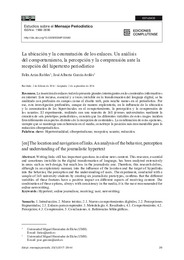Por favor, use este identificador para citar o enlazar este ítem:
https://hdl.handle.net/11000/30872Registro completo de metadatos
| Campo DC | Valor | Lengua/Idioma |
|---|---|---|
| dc.contributor.author | Arias Robles, Félix | - |
| dc.contributor.author | García-Aviles, Jose Alberto | - |
| dc.contributor.other | Departamentos de la UMH::Ciencias Sociales y Humanas | es_ES |
| dc.date.accessioned | 2024-01-31T12:23:36Z | - |
| dc.date.available | 2024-01-31T12:23:36Z | - |
| dc.date.created | 2016-09-02 | - |
| dc.identifier.citation | Estudios sobre el Mensaje Periodístico Vol. 23 Núm. 1 (2017) | es_ES |
| dc.identifier.issn | 1988-2696 | - |
| dc.identifier.uri | https://hdl.handle.net/11000/30872 | - |
| dc.description.abstract | La inserción de enlaces todavía presenta grandes interrogantes en los contenidos informativos en internet. Este recurso, esencial y a veces invisible en la transformación del lenguaje digital, se ha analizado con profusión en campos como el diseño web, pero mucho menos en el periodístico. Por eso, esta investigación profundiza, aunque de manera exploratoria, en la influencia de la ubicación y la conmutación de los hipervínculos en el comportamiento, la percepción y la comprensión de los usuarios. El experimento, realizado con una muestra de 168 jóvenes universitarios mediante la creación de seis prototipos periodísticos, constata que las diferentes variables de estos rasgos inciden favorablemente en aspectos distintos de la recepción de contenidos. La combinación de estas opciones, siempre que se mantenga una coherencia en el medio, constituye la posición más recomendable para la redacción ciberperiodística. | es_ES |
| dc.description.abstract | Writing links still has important questions in online news content. This resource, essential and sometimes invisible in the digital transformation of language, has been analyzed extensively in areas such as web design, but much less in the journalistic one. Therefore, this research delves, although in an exploratory manner, into the influence of the location and the target of hyperlinks into the behavior, the perception and the understanding of users. The experiment, conducted with a sample of 168 university students by creating six journalistic prototypes, confirms that the different variables of these features have a positive impact on different aspects of receiving content. The combination of these options, always with consistency in the media, it is the most recommended for online newswriting. | es_ES |
| dc.format | application/pdf | es_ES |
| dc.format.extent | 16 | es_ES |
| dc.language.iso | spa | es_ES |
| dc.publisher | Universidad Complutense de Madrid | es_ES |
| dc.rights | info:eu-repo/semantics/openAccess | es_ES |
| dc.rights.uri | http://creativecommons.org/licenses/by-nc-nd/4.0/ | * |
| dc.subject | Hipertextualidad | es_ES |
| dc.subject | ciberperiodismo | es_ES |
| dc.subject | recepción | es_ES |
| dc.subject | usuario | es_ES |
| dc.subject | redacción | es_ES |
| dc.subject | Hypertext | es_ES |
| dc.subject | online journalism | es_ES |
| dc.subject | receiving | es_ES |
| dc.subject | user | es_ES |
| dc.subject | newswriting | es_ES |
| dc.subject.other | CDU::0 - Generalidades.::00 - Ciencia y conocimiento. Investigación. Cultura. Humanidades. | es_ES |
| dc.title | La ubicación y la conmutación de los enlaces. Un análisis del comportamiento, la percepción y la comprensión ante la recepción del hipertexto periodístico. | es_ES |
| dc.title.alternative | The location and navigation of links. An analysis of the behavior, perception and understanding of the journalistic hypertext | es_ES |
| dc.type | info:eu-repo/semantics/article | es_ES |
| dc.relation.publisherversion | http://dx.doi.org/10.5209/ESMP.55580 | es_ES |

Ver/Abrir:
2017_La ubicación y la conmutación de los enlaces. Un análisis del comportamiento, la percepción y la comprensión an.pdf
376,03 kB
Adobe PDF
Compartir:
 La licencia se describe como: Atribución-NonComercial-NoDerivada 4.0 Internacional.
La licencia se describe como: Atribución-NonComercial-NoDerivada 4.0 Internacional.
.png)